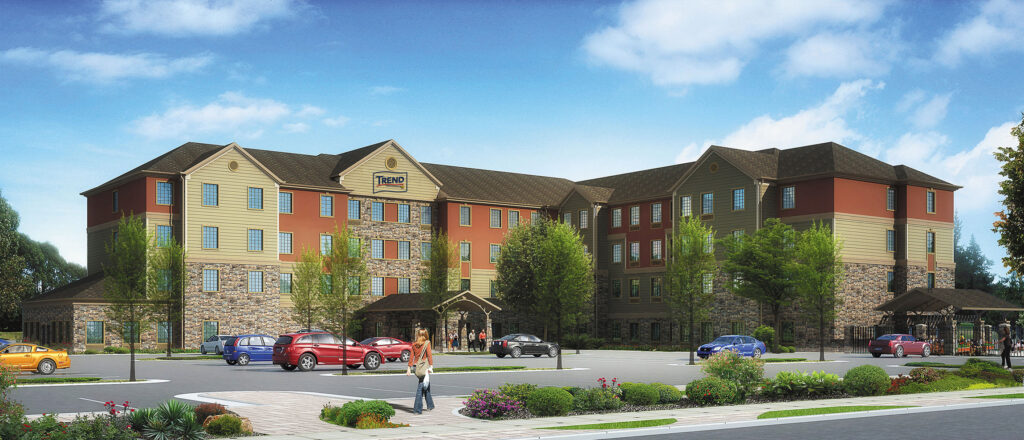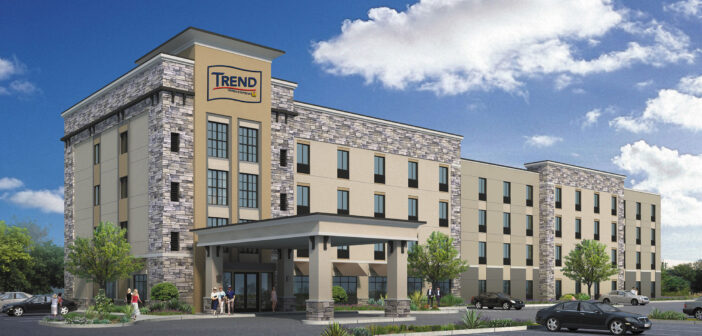My Place Hotels of America launches second brand targeting hoteliers with expiring franchise agreements
by NICK FORTUNA
It takes guts to launch a new hotel brand amid a pandemic, especially since COVID-19 has hit the hospitality industry harder than most, but Ryan Rivett believes he has a winning formula, and success in the industry runs in his blood. If it’s true that fortune favors the fearless, then Rivett and his company have much to look forward to, and he’s inviting savvy hoteliers to come along for the ride.
Rivett is the chief executive of Aberdeen, SD-based My Place Hotels of America, which has 56 My Place Hotels across 27 states and more than 120 in the pipeline. The brand, which debuted in 2012, consists of newly constructed midscale, extended-stay properties, each with about 64 guest rooms catering primarily to transient and business travelers.
In June, the company launched its second brand, Trend Hotels & Suites, a collection of upper-midscale and upscale select-service and extended-stay hotels. The brand mostly is targeting properties built in 2005 or later that are independent or have franchise agreements set to expire. Promising reduced overall franchise fees, low conversion costs, and more robust support than rival franchisors, Rivett believes Trend Hotels & Suites offers a better value to hoteliers.
“The level of relationship-based support that we offer and our understanding of the business from the operator’s perspective are really our key strengths, so that’s what we’re offering to franchises who are in a position to change their affiliation,” Rivett said. “We can bolster their business at a lesser cost and with a greater degree of support than they’re getting from the larger franchise organizations, which have much more layering.
“We’re offering a great deal of infrastructure from a relatively small brand at this point and an opportunity for the franchisor and franchise to grow concurrently. That’s really attractive to a lot of franchises who have said, ‘My property is well located, I’m seasoned in the business, I operate my hotel well, but in many respects, I’m paying too much for my franchise affiliation and the value it brings.’”
ALL IN THE FAMILY
Rivett is the grandson of Ron Rivett, who in 1973 co-founded the Super 8 brand, which is now owned by Wyndham Hotel Group. His family still owns and operates the first Super 8 hotel ever opened, in Aberdeen, along with several other properties.
With My Place Hotels continuing to grow, Ryan Rivett said he’s optimistic that Trend Hotels & Suites can build upon his family’s multigenerational success story. In early August, he said his company was in discussions with more than a dozen hoteliers about converting their properties to the Trend brand.
“It would be nice to see history repeat itself,” Rivett said. “Right now, we’re just doing what we do and, to some degree, ignoring the difficulties of the times and staying on course. It seems like a good plan, and so far, it’s been really well received.”
Trend properties will have a 5-percent base royalty fee, within the industry norm of 4.5 percent to 7 percent, Rivett said. But the company is aiming to keep hoteliers’ total brand-affiliation costs at about 9.5 percent, compared with 13 percent to 19 percent for a typical upper-midscale, branded property, he said.
“There are a lot of us operating in the industry around that 5-percent number, but the important number is the all in – what am I really going to be writing a check for on a monthly basis? – and we’re going to be under 10 percent,” he said.
Rivett said that due to steady industry growth over the past 15 years, there are many midscale and upper-midscale properties with franchise agreements set to expire soon. Some properties that were upper midscale five years ago have been pushed down-market because of increased competition and changing market dynamics. In many cases, hoteliers are facing strong competition from newer properties owned by the same parent company, he said.
“With parent companies having 20 or 30 brands underneath them, including soft branding and collection branding, what we’ve seen is the name brand becomes less important than the ability to distribute available hotel supply and the ability of the operator to provide a consistent guest experience,” Rivett said. “Brands have grown, but not necessarily in proportionality with the value that their name provides.
“In many cases, hotel operators are saying they’re competing with five or six different hotel brands within their same reservation system and within their same market.”

Trend will be looking to prove its worth by tailoring the conversion process to each individual property. This rendering depicts a conversion from Staybridge to Trend.
AN INDIVIDUALIZED APPROACH
Trend Hotels & Suites offers flexible standards focusing on the strengths of individual properties, Rivett said. Amenities such as swimming pools, fitness centers, and free breakfasts – which typically are costly to operate, and heavily marketed but underutilized – aren’t part of Trend’s brand standards. While other brands focus on providing more services and enlarging common areas, Trend’s focus is on giving guests a premium in-room experience at an affordable price, he said.
With their smaller footprint, My Place Hotels typically operate with just a handful of staffers, whereas rivals with 80 to 120 rooms and a full suite of amenities might need two dozen employees, Rivett said. Trend hotels also are designed to operate more efficiently than their peers, which Rivett said will help them weather recessions better than other brands.
The COVID-19 recession likely will mean fewer new hotels being built in the short term, so some large brands see hotel conversions as the surest path to growth. Early indications suggest that the competition for hoteliers with expiring franchise agreements will be fierce. During recent conference calls with investors, executives at Wyndham and Hyatt said they’re devoting large sums to conversions and possibly will offer hoteliers upfront payments and other incentives.
However, hoteliers who are looking to change brands without being demoted to economy or midscale status often must make hefty investments to renovate their properties, Rivett said. With 2020 shaping up as the worst year ever for the industry, most hoteliers aren’t in a position to spend $1 million or more on upgrades, so they may feel that they have no choice but to stick with their brands. Even worse, they may lack the funds to adhere to stringent brand standards and may lose their affiliation.
LOW CONVERSION COSTS
Trend’s brand standards offer hoteliers more flexibility and a streamlined conversion process, Rivett said. The typical conversion might require $35,000 to $45,000 in new exterior and interior signage, and upgrades to fix normal wear and tear may be staggered over time, depending on the condition of the property and the hotelier’s financial situation. Since the typical Trend property will be relatively new, wholesale renovations rarely will be necessary.
“It’s a more progressive schedule of improvements that occurs as performance is re-established following the pandemic and as volume continues to creep up,” Rivett said. “We’re focused on the reality of our circumstances right now and the potential that we identify in each property that we go into. We’re really focused on quality properties that were operated and maintained well pre-pandemic and are either operating well today or working toward getting their feet back underneath them.”
“Hotels are really well positioned to make brand-affiliation changes,” he said. “They may be facing the difficult decision of whether they can sustain operations after required capital improvements that will come back into play in the near future, if they aren’t in play already, depending on the brand and location.”
Rivett said Trend executives are looking to prove their worth by tailoring their marketing and sales strategies to each individual property and market, putting “boots on the ground” and using business-intelligence software. He said his company has made substantial investments in a technology infrastructure that makes My Place and Trend just as visible as larger brands.
When a property converts, a “white-glove onboarding process ensues seemingly overnight,” Rivett said. Once staff training is complete, Trend’s systems-operations team will perform the switch “so as not to miss a single reservation on the books,” he said. The brand will provide ongoing staff-development opportunities to workers, and hoteliers will get the individualized attention they need to thrive, Rivett said.
“Our understanding of each market that we go into is deep,” he said. “It goes beyond data mining and analytics. We actually put in the work to understand each market that we go into, and you get a greater level of communication with us. The access to people at every level of our company is substantially greater than what you’ll find in any other franchise organization.
“We have strategy meetings to look as deep as we can into each market that we’re in, or to identify similarities from market to market, so we know which demographic groups we need to go after to put heads in beds.”




